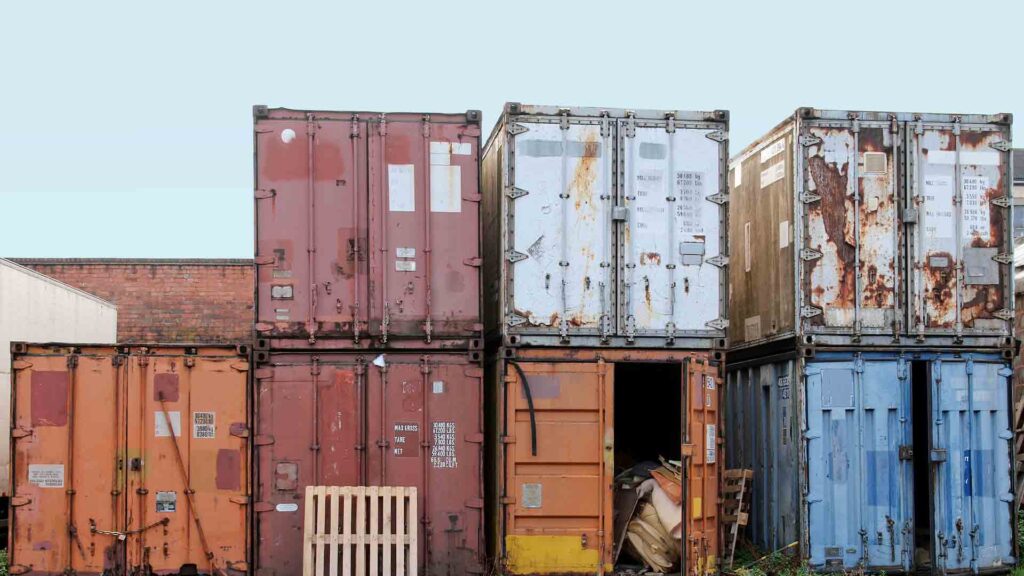What are the reasons for Shipping Container Damage? Shipping container damage can occur due to various reasons, including mishandling during loading and unloading processes, improper stacking of cargo, rough sea conditions during transit, and inadequate packaging of goods. Additionally, environmental factors such as extreme temperatures, moisture, and exposure to saltwater can contribute to corrosion and structural damage. In this blog, we’ll delve into the complexities of shipping container damage, exploring its causes, impact on supply chains, and crucial strategies to safeguard cargo integrity.
Shipping Container Damage: Common Causes
1. Rough Seas and Weather Extremes:
– The unpredictability of the open seas poses a significant challenge. Containers may encounter rough waves, storms, or extreme temperatures, subjecting them to physical stress and potential damage. This is particularly true for sensitive or perishable cargo.
2. Inadequate Packaging:
– The interior of a container is a dynamic environment during transit. Improperly secured cargo or inadequate packaging can result in items shifting, colliding, or even breaking. Implementing comprehensive packaging guidelines is crucial.
3. Poor Handling Practices:
– At various stages of the logistics journey, containers face handling challenges. Loading and unloading processes, as well as overland transportation, can expose containers to rough treatment. Careless handling can lead to dents, scratches, or even more severe structural damage.
4. Container Wear and Tear:
– Containers, especially those in extended service, undergo wear and tear. Rust, weakened structural elements, and compromised integrity become potential issues. Routine inspections and maintenance are vital to identify and address these concerns.
The Ripple Effect on Supply Chains:

1. Financial Impact:
– The financial repercussions of container damage are multifaceted. Repair or replacement costs for damaged containers, loss of valuable cargo, and potential write-offs contribute to financial losses that businesses aim to minimize.
2. Supply Chain Disruptions:
– Container damage disrupts the flow of the supply chain. Delays in the delivery of goods, especially if they require replacement or extensive repairs, can lead to dissatisfaction among customers and strained relationships with suppliers.
3. Reputational Damage:
– A consistent pattern of shipping container damage can harm a company’s reputation. Word-of-mouth, customer reviews, and industry reports can influence the perception of a business’s reliability and competence in managing logistics challenges.
Types of Shipping Container Damage

Understanding the types of shipping container damage is the first step in fortifying the integrity of global supply chains. By implementing preventive measures and swift responses to emerging issues, businesses can navigate the complexities of international logistics with resilience and reliability. Let’s delve into the various forms of shipping container damage and the implications they carry.
1. Dents and Dings:
– Cause: Dents and dings are often the result of rough handling during loading and unloading processes or from contact with other containers.
– Implications: While superficial, these damages can compromise the structural integrity of the container. Water can seep into dented areas, leading to rust and corrosion.
2. Corrosion:
– Cause: Corrosion is a natural consequence of exposure to harsh maritime conditions, especially saltwater. It often occurs in aging containers or those with compromised protective coatings.
– Implications: Corrosion weakens the metal structure, making the container susceptible to further damage. Regular inspections and preventive maintenance are essential.
3. Structural Damage:
– Cause: Structural damage can result from collisions, mishandling, or wear and tear over time.
– Implications: Severe structural damage compromises the container’s ability to protect cargo. It may lead to complete write-offs or necessitate costly repairs.
4. Water Damage:
– Cause: Water damage can occur through leaks in the container, often due to rust, faulty seals, or inadequate repairs.
– Implications: Water damage poses a significant threat to cargo integrity, especially for goods sensitive to moisture. It can lead to mold, mildew, and corrosion.
5. Floor Damage:
– Cause: Rough handling during loading and unloading can damage the container floor, as well as the placement of heavy or sharp-edged cargo.
– Implications: A damaged floor compromises the container’s structural strength and can impact the stability of stacked containers during transportation.
6. Door Damage:
– Cause: Door damage can occur from mishandling, collisions, or issues with the locking mechanisms.
– Implications: A damaged door affects the security and weather-tightness of the container. It can lead to unauthorized access, theft, or damage to the cargo due to exposure.
7. Fire Damage:
– Cause: Fire incidents during transportation or while the container is stationary can result in extensive damage.
– Implications: Beyond the immediate loss of cargo, fire damage can render the container unusable and pose safety risks during subsequent shipments.
8. Tampering and Vandalism:
– Cause: Tampering or vandalism can occur during transportation, storage, or at ports.
– Implications: Besides potential theft or damage to the cargo, tampering compromises the security of the entire supply chain.
Strategies to Safeguard Against Shipping Container Damage:

1. Robust Packaging Protocols:
– Establishing and enforcing stringent packaging standards is the first line of defense. This includes proper cushioning, secure strapping, and adherence to weight limits to prevent cargo movement.
2. Weather-Resistant Containers:
– For goods sensitive to weather conditions, investing in weather-resistant containers or employing additional protective measures, such as moisture barriers, shields cargo from the elements.
3. Quality Inspection and Maintenance:
– Regular inspections should be part of routine maintenance practices. Identifying and rectifying structural issues in containers before they escalate ensures the longevity and reliability of the container fleet.
4. Technology Integration:
– Modern technology offers solutions for real-time monitoring. IoT sensors, embedded within containers, provide data on environmental conditions, vibrations, and potential shocks, enabling swift intervention in case of deviations from the norm.
Conclusion: Smooth Sailing in the Logistics Landscape
Shipping container damage is an ever-present challenge in the logistics seas. However, with proactive measures, strategic investments in technology, and a commitment to robust packaging standards, businesses can navigate these challenges successfully. By safeguarding cargo integrity, mitigating financial risks, and ensuring timely deliveries, companies can turn the tides in their favor and secure a reputation for reliability in the complex world of global logistics.
While the journey across seas may pose challenges, safeguarding your cargo against shipping container damage is a strategic imperative. Partner with Galaxy Freight to ensure that your shipments navigate the seas smoothly, arriving at their destination in pristine condition. Contact us today to experience the Galaxy Freight advantage in securing your supply chain.



